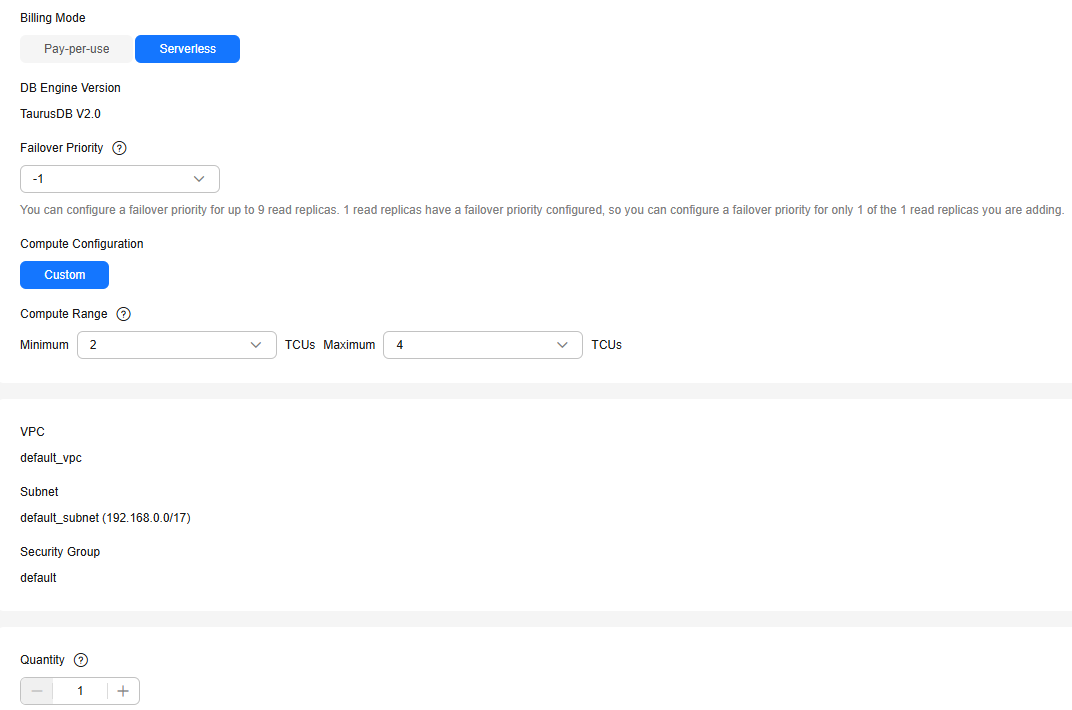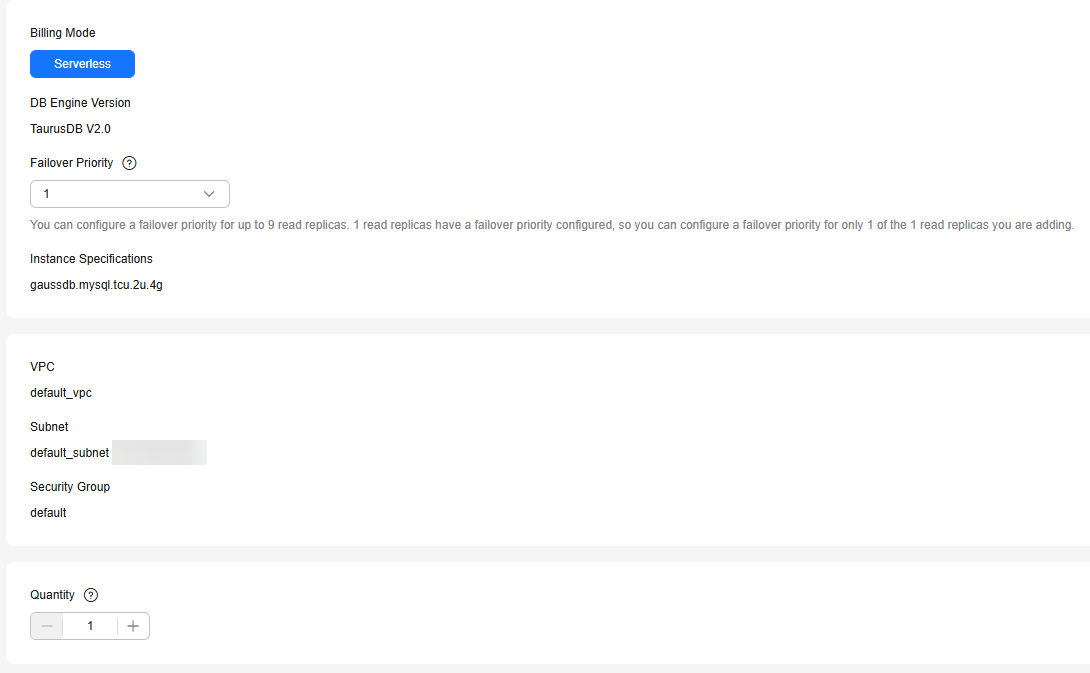Adding Serverless Read Replicas
You can add serverless read replicas to an existing instance as required.
Constraints
- The first time you add serverless read replicas to an instance with fixed specifications, you need to initialize a scaling policy, that is, set the compute range. If you need to modify the scaling policy later, click the instance name to enter the Basic Information page, click Change in the Serverless Information area, and modify serverless parameters.
- Adding serverless read replicas is mutually exclusive with the auto scaling function. If the serverless function has been enabled for an instance with fixed specifications, the auto scaling function cannot be enabled and vice versa.
Billing
After serverless read replicas are added, their compute is billed by hour. For details, see Product Pricing Details.
Adding Serverless Read Replicas
- Log in to the TaurusDB console.
- On the Instances page, locate the instance you want to add read replicas to and choose More > Create Read Replica in the Operation column.
- On the displayed page, select the serverless billing mode and set other parameters.
Figure 1 Creating serverless read replicas

Table 1 Parameter description Parameter
Description
Failover Priority
The failover priority of a serverless read replica is fixed to -1. During a failover, the serverless read replica will not be promoted to primary. The failover priority for serverless read replicas cannot be changed.
Compute Range
- Minimum TCUs: Set the minimum compute. 1 TCU is approximately equal to 1 CPU and 2 GB of memory. The initial specifications of a new serverless read replica are the minimum compute.
- Maximum TCUs: Set the maximum compute.
Quantity
Up to seven serverless read replicas can be created for each instance.
- Click Next.
- Check the read replica settings.
- If you need to modify the settings, click Previous.
- If you do not need to modify the settings, click Submit.
- View or manage the created read replicas in the Node List area on the Basic Information page.
- Log in to the TaurusDB console.
- On the Instances page, locate the instance you want to add read replicas to and choose More > Create Read Replica in the Operation column.
- On the displayed page, set Failover Priority and Quantity.
Figure 2 Creating serverless read replicas

Table 2 Parameter description Parameter
Description
Failover Priority
Failover priority ranges from 1 for the first priority to 16 for the last priority. This priority determines the order in which read replicas are promoted when recovering from a primary node failure. Read replicas with the same priority have a same probability of being promoted to the new primary node.
Quantity
Up to seven serverless read replicas can be created for each instance.
- Click Next.
- Check the read replica settings.
- If you need to modify the settings, click Previous.
- If you do not need to modify the settings, click Submit.
- View or manage the created read replicas in the Node List area on the Basic Information page.
Follow-up Operations
- If you want to modify the scaling policy, see Changing the Maximum and Minimum Numbers of Serverless Read Replicas.
- To adjust the number of read replicas, there must be at least one proxy instance and new nodes can automatically be associated with the proxy instance, and there are serverless read replicas. If you require that read replicas be automatically associated with the proxy instance, go to the Database Proxy page.
- Once you enable the function to adjust the number of serverless read replicas for an instance with fixed specifications, the routing policy of proxy instances will remain unchanged. However, if the routing policy is weighted, an inappropriate weight configuration may render the function invalid. To prevent your workloads from being affected, you are advised to configure the same weight for serverless read replicas or use the load balancing routing policy when adjusting the number of serverless read replicas.
- Each instance supports a maximum of 15 read replicas. The total number of serverless read replicas and existing non-serverless read replicas in an instance cannot exceed 15, and the number of serverless read replicas cannot exceed 7.
If an instance has 13 non-serverless read replicas, the maximum number of serverless read replicas can be set to 2 instead of 7.
If an instance has 5 non-serverless read replicas, the maximum number of serverless read replicas can be set to 7 instead of 10.
- If you want to delete a serverless read replica, see Deleting a Read Replica.
Feedback
Was this page helpful?
Provide feedbackThank you very much for your feedback. We will continue working to improve the documentation.See the reply and handling status in My Cloud VOC.
For any further questions, feel free to contact us through the chatbot.
Chatbot





